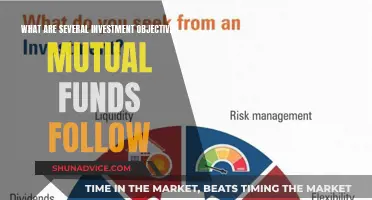
Investing in mutual funds is a great way to build a diversified portfolio without the extra cost or hassle. They are a collection of investors' money that fund managers use to invest in stocks, bonds, and other securities. Mutual funds are an excellent option for those who don't have the time, education, money, or willingness to manage a large portfolio of investments.
1. Set an investing goal: Identify what you're investing for, such as saving for retirement, buying a home, or education.
2. Decide on an account type: Choose between a standard brokerage account, a 401(k), an IRA, or a Roth IRA, depending on your specific goals.
3. Determine your asset mix: Decide on the percentage of your portfolio that will be invested in stocks, bonds, and other holdings based on your goals, time frame, and risk tolerance.
4. Pick an investment strategy: Choose between active and passive funds. Active funds aim to beat the market through stock-picking and research, while passive funds aim to match market benchmarks.
5. Research mutual fund companies: Look into well-known companies like Vanguard or Fidelity, considering factors such as regulatory issues and fund fees.
6. Research mutual funds: Study the menu of options provided by your chosen fund company, considering factors like fees, historical performance, and investment strategy.
7. Open an investing account: Set up a 401(k), taxable brokerage account, IRA, or work with a robo-advisor or financial advisor.
8. Buy mutual fund shares: Consider factors like investment minimums, share classes, and trading mechanics when purchasing mutual fund shares.
9. Be a good long-term investor: Avoid trying to time the market and focus on being a successful long-term investor by riding out the market's ups and downs.
10. Don't forget about taxes: Understand the tax implications of investing in mutual funds, including capital gains taxes and dividend taxes.
Remember to always consider your financial goals, risk tolerance, and investment time horizon when investing in mutual funds.
| Characteristics | Values |
|---|---|
| Investment Vehicle | A mutual fund is an investment vehicle that pools money from multiple investors to purchase a diversified portfolio of stocks, bonds, or other securities. |
| Diversification | Mutual funds give individual investors access to diversified, professionally managed portfolios. |
| Management | Mutual funds are managed by professional money managers. |
| Trading | Mutual funds trade on exchanges. |
| Risk | Mutual funds are known to be safer investments than purchasing individual stocks. |
| Returns | The average annual return of the S&P 500 is about 8% per year. |
| Fees | Mutual funds charge annual fees, expense ratios, or commissions, which lower their overall returns. |
| Liquidity | Mutual funds are highly liquid investments. |
| Taxes | Mutual funds have tax implications. For example, you may owe taxes on any capital gains your investments have made. |
What You'll Learn

Active vs passive funds
When deciding how to invest in mutual funds, one of the first choices you'll make is whether to invest in active or passive funds. Here's what you need to know about the differences between the two:
Active Funds
Active funds are managed by professionals who research the market and buy with an eye toward beating it. Active investing takes a hands-on approach and requires a portfolio manager, whether that person is managing their own portfolio or a professional managing it for them. Active fund managers buy and sell daily based on their research, trying to find stocks that can beat the market averages. This type of fund tends to be more expensive, with higher fees and expense ratios, as investors are paying for the fund manager's time and expertise.
Passive Funds
Passive investing, on the other hand, is a more hands-off approach. Passive funds don't have a fund manager making active decisions about what to buy and sell. Instead, they aim to mimic the market by tracking an existing group of investments called an index, such as the S&P 500. This type of fund tends to be cheaper, with lower fees, as there is no fund manager to pay.
Active vs. Passive: Which is Better?
While active investing may appeal to those who want to try to beat the market, passive investing tends to deliver better overall returns. Despite the expertise and effort of active fund managers, the majority of them underperform the market benchmark they are trying to beat. Passive funds, on the other hand, tend to perform better because they have lower fees and don't try to beat the market but rather aim to match its long-term average return.
Additionally, passive investing is often quicker and easier, as it doesn't require the same level of research and decision-making as active investing. However, passive investing requires a long-term mindset and the ability to resist the temptation to react to the market's short-term fluctuations.
In conclusion, while active investing may be suitable for some investors, passive investing in mutual funds generally looks like the winner for most.
Mutual Fund Investment Strategies for Your 401(k) Plan
You may want to see also

Investment budget
When it comes to investing in mutual funds, the first step is to set clear financial goals and decide on an investment strategy. Ask yourself what you are investing for and what your risk tolerance is. Are you saving for retirement, a house, or your child's education? Depending on your goals and risk appetite, you can then decide on an asset mix, determining what percentage of your portfolio will be invested in stocks, bonds, or other holdings.
The next step is to choose an account type. You can open a standard brokerage account through an investment company or bank, or take advantage of an employer-sponsored retirement account such as a 401(k). If your employer doesn't offer a retirement plan, you can open a traditional or Roth IRA with a wider range of investment options.
Now it's time to decide on the right mix of stocks and bonds. If you're in your 20s, a 100% stock allocation could be suitable, while those closer to retirement might prefer a more conservative mix, such as the 60/40 portfolio (60% stocks and 40% bonds).
You'll then need to pick an investment strategy. Do you want to pay a portfolio manager to actively pick stocks that aim to beat the market, or are you happy with passive funds that aim to match market performance? Active funds tend to be more expensive due to research costs, while passive funds are cheaper and often outperform active funds despite their lower fees.
When it comes to budgeting for your mutual fund investment, there are a few things to keep in mind. Firstly, mutual funds have different minimum investment requirements, ranging from $100 to $3,000, with some funds even offering a $0 minimum. Secondly, you'll want to consider the fees associated with mutual funds, including annual fees, expense ratios, and commissions, which will impact your overall returns. These fees vary depending on the type of fund and the company offering them, so be sure to research the costs before investing.
Once you've decided on your budget and chosen your funds, you can open an investing account and start buying mutual fund shares. Remember to consider the different share classes, as some have built-in fees meant to compensate financial advisors. Investor shares, on the other hand, tend to have lower costs. Keep in mind that mutual funds can only be bought or sold once per day at the closing price of the market.
In summary, determining your investment budget for mutual funds involves setting clear financial goals, deciding on an asset mix, choosing an account type, and researching the fees associated with different funds. By carefully considering these factors, you can make an informed decision about how much to invest in mutual funds.
Funding Investments: Strategies for Covering Total Amounts Received
You may want to see also

Brokerage account options
There are several brokerage account options to choose from when investing in mutual funds. Here are some of the most common types:
- Standard Brokerage Account: You can open a standard brokerage account through an investment company or bank, which allows you to invest in a wide range of securities such as stocks, bonds, and mutual funds.
- 401(k): If your employer offers a retirement account, you may already have a 401(k) plan. These tax-advantaged accounts are common in many employers' benefits packages, and mutual funds are typically the most popular investment option.
- Traditional Individual Retirement Account (IRA): If your employer doesn't offer a retirement savings plan, you can open a traditional IRA at most investment companies. IRAs offer a wider range of investment options than 401(k)s.
- Roth IRA: Roth IRAs are another popular option for retirement savings, offering a variety of investment choices, including mutual funds. Roth IRAs are funded with after-tax dollars, so your contributions grow tax-free, and you won't owe taxes when you withdraw in the future.
- Taxable Brokerage Account: You can open a taxable brokerage account at an online broker if you're investing for a goal outside of retirement. These accounts lack the tax benefits of 401(k) plans or IRAs, but they offer the flexibility to make withdrawals at any time without penalties.
- Education Savings Accounts: If you want to save for your children's college education, you can open a 529 college savings account and invest in mutual funds.
When choosing a brokerage account, it's important to consider factors such as fees, investment choices, research and educational tools, and ease of use. Some popular brokerage firms include Fidelity and TD Ameritrade. Additionally, you may want to consider working with a robo-advisor or a financial advisor, depending on your preferences and level of involvement in managing your investments.
Atram Alpha Opportunity Fund: A Guide to Investing
You may want to see also

Mutual fund fees
Mutual funds charge annual fees, expense ratios, or commissions, which lower their overall returns. These fees cover the fund's operating expenses, including management fees, administrative costs, and marketing expenses. It's important to understand these fees as they can significantly affect your investment returns over time. Here are some common types of mutual fund fees:
- Expense ratio: This is an annual fee that covers the fund's operating expenses, including management fees, administrative costs, and marketing expenses. It is expressed as a percentage of the fund's average net assets and is deducted from the fund's returns. The average expense ratio for an active fund is around 0.6%, while for a passively managed fund, it is around 0.12%.
- Sales charges or loads: Some mutual funds charge sales fees, known as "loads", when you buy or sell shares. Front-end loads are charged when you purchase shares, while back-end loads are assessed if you sell your shares before a certain date. No-load funds, on the other hand, don't charge any sales commissions.
- Redemption fees: Some mutual funds charge a fee when you sell shares within a short period (usually 30 to 180 days after purchasing them. This fee is designed to discourage short-term trading and promote stability.
- Other account fees: Some funds or brokerage firms may charge extra fees for maintaining your account or transactions, especially if your balance falls below a certain minimum.
When investing in mutual funds, it's essential to be mindful of these fees and their potential impact on your returns. By comparing expense ratios and avoiding unnecessary sales charges, you can minimize the costs associated with investing in mutual funds. Additionally, consider the benefits of investing in no-load funds or purchasing directly from the mutual fund company to reduce brokerage fees and commissions.
Best Funds to Invest in NPS: Where to Start?
You may want to see also

Mutual fund portfolio management
Diversification:
Mutual funds offer instant diversification by pooling money from multiple investors to purchase a wide range of stocks, bonds, and other securities. Diversification is a risk management strategy, so review your mutual fund portfolio regularly to ensure it aligns with your risk tolerance and investment goals.
Asset Allocation:
Determine the appropriate mix of stocks, bonds, and other assets for your portfolio. A common strategy is the 60/40 portfolio (60% stocks and 40% bonds). However, you can also consider investing in commodities like gold and oil for further diversification.
Active vs. Passive Management:
Active management involves a fund manager actively picking stocks and bonds to try to beat the market. Passive management, on the other hand, aims to replicate the performance of a market index, like the S&P 500. Passive funds tend to have lower fees, and historically, they have often outperformed active funds.
Expense Ratios and Fees:
Mutual funds charge annual fees, expense ratios, or commissions. The expense ratio is the annual fee charged as a percentage of your investment and can impact your returns over time. Be mindful of other fees, such as sales charges or loads, redemption fees, and account maintenance fees.
Research and Due Diligence:
Conduct thorough research on the mutual fund companies and the specific funds they offer. Evaluate factors such as past performance, expense ratios, management style, and regulatory compliance. Utilize fund screeners and research firms to aid your decision-making.
Regular Monitoring and Rebalancing:
Don't forget to regularly monitor the performance of your mutual fund investments. While long-term investing is generally recommended, you should still periodically review your portfolio to ensure it aligns with your investment strategy and goals. Consider rebalancing your portfolio at least once a year to maintain your desired asset allocation.
Tax Implications:
Understand the tax implications of investing in mutual funds. You may owe capital gains taxes when you sell mutual fund shares, and you may also be taxed on dividends received. Additionally, mutual funds themselves can trigger capital gains taxes as they trade stocks and bonds.
Long-Term Perspective:
Resist the urge to time the market. Focus on long-term investment horizons, as short-term performance can be volatile and unpredictable. Historical data suggests that long-term annualized returns provide a more realistic expectation of future performance.
Exit Strategy:
Finally, consider your exit strategy when investing in mutual funds. If you invest in mutual funds with backend loads, you'll pay a fee when you cash out. Additionally, consult a financial advisor or tax professional to minimize potential tax liabilities on your investments.
A Guide to Investing in the 10T Fund
You may want to see also
Frequently asked questions
Mutual funds are a great way to build a diversified portfolio without a lot of extra cost or hassle. They are managed by professionals and allow you to invest in a range of securities rather than just one or two.
You should first identify your investment goals and risk tolerance. Then, research different mutual funds that align with your goals and consider factors such as past performance, expense ratios, and management style.
There are four main categories of mutual funds: stock, money market, bond, and target-date funds. Stock funds invest primarily in stocks, bond funds in bonds, and money market funds in short-term debt instruments. Target-date funds automatically adjust their asset allocation based on a specified target date.
You can invest in mutual funds through an employer-sponsored retirement plan, such as a 401(k) or 403(b), or by opening a brokerage account. You will then need to decide on the right mix of stocks and bonds for your portfolio and choose between actively and passively managed funds.
Mutual funds typically charge annual fees, expense ratios, or commissions, which will reduce your overall returns. Some mutual funds also charge sales fees or "loads" when you buy or sell shares.







